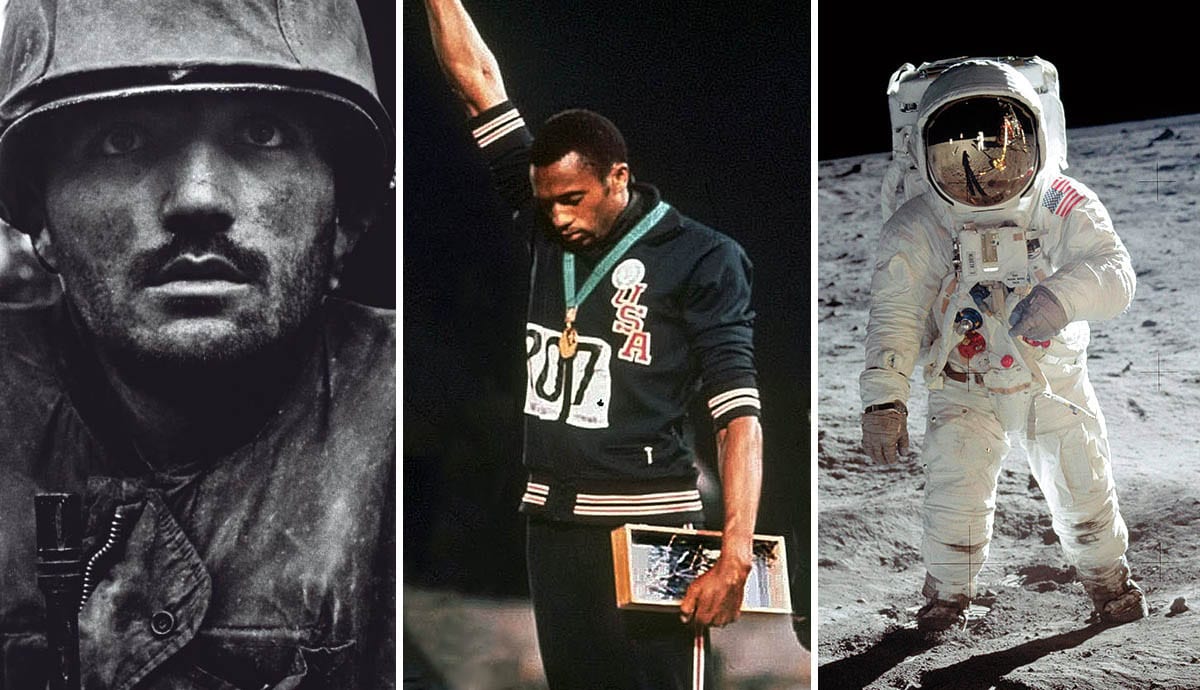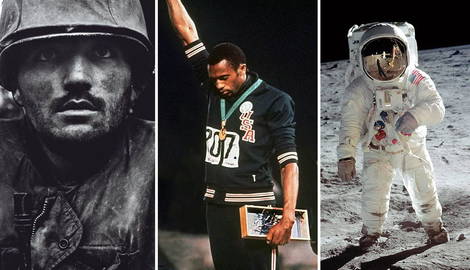
Documentary photographs are one of the most direct and confrontational art forms, grabbing a snapshot moment before it disappears forever. In contrast with other types of photography, documentary photographs are more instantaneous, responding to events without staging or artifice. This means the photographer has to be in the right place at the right time, waiting for what the great photographer Henri Cartier-Bresson called “the decisive moment.”

As well as capturing these “decisive moments” in history, there is often a brutal honesty to documentary photographs which can make for difficult viewing. They expose uncomfortable truths we might rather turn away from, tying it closely with photojournalism. It is this gritty, ardent quality that makes the medium so important, encouraging us to think deeper about the state of the world in which we are living. Every now and then, a documentary photograph appears that concisely captures the spirit of the zeitgeist, and it is these images that become a permanent marker of our history. Writer Susan Sontag describes these photographs in her radical essays On Photography, 1977, as “images (that) do not seem to be statements about the world so much as pieces of it.”
The History of Documentary Photographs

The history of documentary photography is almost as old as photography itself, dating back to around the mid-19th century when photographers began taking cameras out into the wider world as a tool for documentation. British photographer Philip Delamotte is often cited as an early example of documentary-style photography. He captured the disassembly of Crystal Palace in Hyde Park, London in 1852, and its reconstruction and expansion at Sydenham in the suburbs of London in 1854. His archive of photographs was an important record of this impressive feat of engineering, particularly following the destruction of Crystal Palace by fire in 1936.
American photographer Matthew Brady was one of the first to use photography as a record for capturing harrowing political unrest, documenting the American Civil War in 1861 and portraying some of the darkest days in history from the front line.

Some early photographers adopted documentary photography as an agent for social change, documenting unsanitary housing or poor living conditions to raise awareness of their struggles to a broader audience. American photographer Jacob Riis documented the cramped, dirty living conditions of early New York in his publication How the Other Half Lives, 1890.

Scottish photographer Thomas Annan shot in the streets, wynds, and closes of old Glasgow in the late 19th century, revealing just how difficult these people’s lives truly were. The advent of magazines including TIME, Vanity Fair, and LIFE in the early 20th century did much to promote the work of documentary photographers such as Annan, Riis, and Cartier-Bresson; with regular photographic and journalistic features on the most important causes of the day, particularly throughout the two World Wars.
Since this time, photographers have continued to explore the role of documentary photographs as a potent tool for capturing historical moments and raising awareness of a political cause. Let’s take a look through some of the most enduring photographs from throughout history, which remain thought-provoking testaments to the time in which they were taken.
1. Alfred Stieglitz, The Steerage, 1907

Alfred Stieglitz’s The Steerage, 1907, is a complex flurry of movement as passengers board a ship headed for Europe. On the one hand, the work gathered attention for its concise ability to contrast the dank lower “steerage” quarters where the poorest passengers had to go with the clean order and open air of the first-class travelers above them.
Additionally, the photograph has also been highly praised for its ability to convey the complex language of Cubism in photographic form as disordered shapes, lines, and textures intermingle and capture the increasing fragmentation of the Modernist age.
2. August Sander, Bricklayer, 1928

German photographer August Sander’s Bricklayer, 1928 is one of the most iconic images of the 20th century. It conveys the determined grit and unflinching hard-work of the post-war generation in a simple, well-composed portrait. Sander made this image as part of his huge survey series People of the 20th Century, which documented people from all walks of German life. He deliberately took a dispassionate, unbiased eye in the series, photographing people from every social stratum. He included soldiers, circus performers, and politicians and captured them all in the same manner to give equal weight and importance to all his subjects.
3. Unknown Photographer, Lunch Atop A Skyscraper, 1932

The gravity-defying Lunch Atop a Skyscraper, 1932, is one of the most reproduced images of all time, neatly encapsulating the sky-bound cityscape of Modernist America. The men lined up precariously along a beam and, enjoying their lunch, were in the process of building the Rockefeller Center. The photograph was taken as a promotional tool to promote the skyscraper complex. The photograph also promoted a bold new American spirit, one that was daring and resilient in the face of war and the Great Depression.
4. Dorothea Lange, Migrant Mother, 1936

Dorothea Lange’s Migrant Mother, 1936, remains to this day a universal emblem of human suffering. The photograph was taken on a migrant farm in Nipomo, California, and portrays Florence Owens Thompson holding a baby with two of her young children huddling in close. A mother to seven children in total, Thompson’s face is etched with lines of worry as she gazes towards an uncertain future. From the moment it was published in a San Francisco newspaper in 1936, the image came to encapsulate the dire poverty endured by many migrant Americans. During the Great Depression, many struggled to work on unproductive land following the devastation of the Dust Bowl.
5. Alfred Eisenstaedt, V-J Day In Times Square, 1945

Alfred Eisenstaedt’s V-J Day in Times Square, 1945 is a worldwide emblem symbolizing the joyous spirit of celebration at the end of the war. The photograph was taken during a street party following the announcement that the Second World War was officially over, and a US Navy sailor grabs and tilts back a young nurse, kissing her on the lips.
At the time, the image encapsulated the passionate and unbridled joy of the moment. However, more recently, some have suggested the nurse may not have been welcoming to his advances. Even so, the message behind the image is one of hope and faith that rings true today.
“People tell me that when I’m in heaven, they will remember this picture,” said Eisenstaedt.
6. John Dominis, Black Power Salute, 1968

John Dominis’ Black Power Salute, 1968, captures the moment when two African-American athletes, Tommie Smith and John Carlos, won gold and bronze medals at the Olympic Games in Mexico City. Both athletes bowed their heads and raised their black-gloved fists high as the American National Anthem played out, staging a powerful silent protest against racism. Their quiet, understated act of resistance has become a universal symbol for Black power, with many activists since then replicating this same pose.
7. Don McCullin, Shell-shocked US Marine, The Battle Of Hue, 1968, Printed 2013

Many documentary photographers braved the brutalities of the Vietnam War to capture the real-life atrocities, but English photographer Don McCullin’s Shell-shocked US Marine, 1968, is one of the more harrowing ones. He turns the camera away from the action and towards the psychological trauma of individual soldiers.
This photograph was taken during the Battle of Hue, one of the worst and most destructive conflicts in the Vietnam War. Seen clutching his rifle and staring into the middle-distance, the stunned, shell-shocked soldier demonstrates the long-lasting horrors of war that live on long after the fighting has ended.
8. Neil Armstrong, A Man On the Moon, 1969

World-renowned astronaut Neil Armstrong took his iconic photograph, A Man on the Moon, 1969, of his fellow-traveler Buzz Aldrin. The pair made history by taking the first steps on the moon’s surface.
Although Armstrong was technically the first to take those momentous steps, this somewhat unstaged, informal photograph of Aldrin has stood the test of time, catching the dusty footprints and unsteady footing of the intrepid explorer. At the same time, Armstrong can be seen looking back in Aldrin’s reflective visor.
9. Nan Goldin, Nan and Brian In Bed, 1983

Nan Goldin’s seemingly informal photograph Nan and Brian in Bed, 1983, remains one of the most celebrated images of the modern era, neatly encapsulating the painful power play between two lovers. There is a raw intimacy at the heart of the picture – Goldin is the woman on the bed, eying her partner Brian with a mixture of suspicion and longing. Meanwhile, he sits away from her and gazes out towards the golden sunset, suggesting the slow and steady waning of their relationship.
Documentary Photographs and Their Role Today

In the late 21st century, the roles once played by documentary photography have been largely replaced by television reportage and digital media. But there is still much demand for documentary photography today in magazines, newspapers, and gallery walls. It remains an arresting medium with the power to invoke strong reactions and political reform. Many documentary photographers of recent times continue to record conflicts as they happen around the world, such as the South African artist Guy Tillim, who documents the troubled regions of Sub-Saharan Africa. Others create a searing critique of today’s society, such as Ukrainian artist Boris Mikhailov, who portrays marginalized people struggling to get by on the edges of post-Soviet society, setting them amidst a brooding, atmospheric blue light to amplify their emotional impact.










